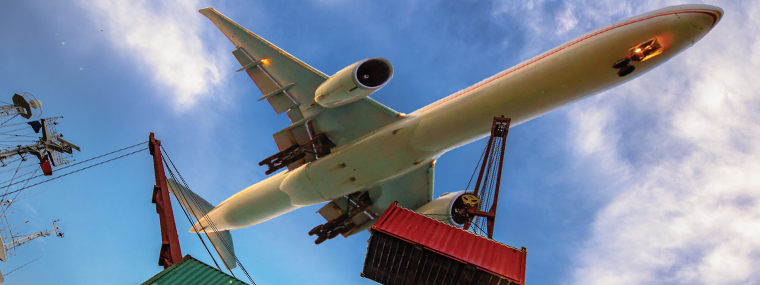
Supply Chain Challenges and Resolutions
By Diane M. Calabrese / Published November 2021

Don’t count supply chains among 21st century concepts or their breakdown. Supply chains are as old as human interaction.
Supply chains were once shorter, and they were often more localized. (But don’t count on localization too much—seafarers like the Phoenicians had a way of getting around and moving supplies between peoples.)
Contemporary and ancient chains share the same potential problem: if a link is severed, there’s trouble to be had.
Readers have been experiencing supply chain issues since early in 2020. The challenge of finding alternate routes of travel or alternative suppliers is great, but it is not new. Even before disruptions caused by cascading lockdowns, there have been disruptions caused by natural disasters and political upheaval. The reality of disruptions is not new, but the enormity of some of them may be.
Overarching now is the intimately linked nature of everything. A raw material shortage affects a supplier. The supplier in turn must disappoint its buyers.
“We’ve had our share of challenges in 2021,” says Mike Tonies, senior director of sales at Hydra-Flex Inc. in Savage, MN. “Several of our suppliers are struggling to get the raw materials to make a few components we source from them.”
And, explains Tonies, the situation is likely to remain unchanged in the near future. “What we are hearing from suppliers is to expect disruptions to continue in the new year.”
Tonies’ company has developed a strategy to compensate for the reality. “In order to meet demand, we are partnering with several key suppliers to communicate our 2022 forecasts much earlier than we have in prior years, which will help put both parties in the best position to succeed.”
Being proactive is what Tonies recommends. “Communication is key,” he says. “Engage with your suppliers by sharing the vision of how they play a key role in servicing the customers despite being a few levels removed.”
Raw materials. Products. Transportation. If any one of them goes missing, the chain breaks.
“We have had numerous supply chain challenges with most of our vendors, but the largest hurdle we have faced is getting our products from overseas to us in a timely fashion,” says Dave Hildebrand, manager at Barens Inc. in Seneca, PA. He cites some causes familiar to many.
“With the reduced capacity of containers and companies supplying transportation to the closing of ports in Asia, it has become imperative to increase order levels,” says Hildebrand. “Also, the shipping costs have doubled or tripled in the last six months, creating pressure to increase selling prices several times this year, and the outlook for the future is not very encouraging.”
Hildebrand does not see the difficulties abating in the near term. “The challenges will definitely continue into 2022,” he says. “The only thing we can do is increase ordering levels and attempt to find alternate sources. Since the pressure washer industry relies heavily on foreign-made products, the options are limited.
Forbearance is needed, and that’s what Hildebrand recommends as a way of dealing with the unpredictability of linkages. “Just smile and know we are definitely all in this together,” says Hildebrand. “But it sure takes the fun out of being in business.”
As for resolutions to make a modification in the business plan or take action that will somehow strengthen chains, there is no immediate answer. “I’m not sure what we can do differently—only hope the powers in government get their acts together and let us all do what we do best without limitations,” says Hildebrand.
Time taken to accomplish workarounds can, of course, become a problem in itself. While another link is being established, a customer may be finding a new vendor.
Dennis Black, president of McHenry Pressure Cleaning Systems Inc. in Frederick, MD, sums it up this way: “We have had multiple problems with not being able to get equipment and supplies. That includes one case of losing the sale because of excessive delays in getting the equipment.”
How does it look from Black’s vantage as he prepares for next year? Will the problems continue?
“Yes, unfortunately, I see delays well into 2022,” says Black. “We are also very concerned about material costs and equipment cost increases.” In the context of price increases, Black notices a troubling indicator. “We are starting to see increases on equipment already ordered.” The after-order price increase puts a distributor in position for a loss of profit. “It means we take an order from a customer for something at a certain price,” explains Black. “We then get an increase in cost from the manufacturer, lowering our profit margins.”
Black explains he is still thinking about what more can be done and whether there is a role for industry colleagues working in a collaborative way to keep supply chains moving. “I don’t know the answer,” says Black.
But Black speculates that some approaches may help. “Work together as much as possible,” he says. “Plan ahead as much as possible. Communicate.”
Looking forward with a resolution or a business plan modification, Black will adjust as much as possible. It begins with a “plan for attempting to have what we need without being overstocked.”
The balance point for in stock and overstock can be a bit tricky. “We are being encouraged to order more,” says Black. “But it has to be paid for some time.”
Despite the tenuous links involving raw materials, products, and transportation, the chains of communication should be kept strong, advises Black. “We will communicate with our customers and hopefully have our manufacturers work with us,” he says.
Counterintelligence Assistance?
Yes, the National Counter-intelligence and Security Center (NCSC) considers reducing the threats to U.S. supply chains as one of its five pillars for 2020–2022. In a document titled “Supply Chain Risk Management” (https://www.dni.gov/files/NCSC/documents/supplychain/20200925-NCSC-Supply-Chain-Risk-Management-tri-fold.pdf), the Office of the Director of National Intelligence recognizes the ever-increasing threat to economic sectors and infrastructure in the United States.
The NCSC document provides a clear-eyed view of the vulnerability of U.S. supply chains. While members of our industry are dealing with the transparent breaks caused by fewer raw materials, fewer products, and fewer ways to move goods, the intelligence entity is focusing on a parallel—and troubling—track.
According to the NCSC, foreign adversaries attempt to access supply chains at multiple points (e.g., concept, design manufacture, and maintenance). The intent of doing so is nefarious.
Manufacturers, distributors, and suppliers must take steps to manage risks to supply chains that arise because of ease of access by unauthorized parties. That access comes via weak firewalls, poor data encryption, radio frequency tools, Bluetooth devices, and so on.
Yet NCSC reminds businesses that it’s not only state-of-the-art technologies that provide access points to those with ill intent but also the most ordinary of entry points. Counterfeiting, product tampering, and plain-old product theft are threats to the supply chain.
It’s all a lot to consider. If a supply chain remains intact with raw materials, products, and transport connecting one to the other, it may be broken by a cyber-criminal.
The Association of Supply Chain Management (https://www.ascm.org/eiu-benchmark) puts an emphasis on resilience. And the word resilience (think flexibility) is a good one to keep in mind when planning or making a business resolution for 2022.
Resolutions
Do something. Redundancy can reduce disruption. Should a manufacturer use more than one transport company for deliveries? If one goes down, another one or two may be functioning and perhaps able to take on more work.
Many of the same strategies used to prepare for natural disasters can reduce problems with supply chains. See Ready.gov for recommendations on how to fortify a business so that days without electricity or a flood or a structural loss do not close it for good. Adapt them to supply chains.
Consider the number of links in a chain. Reducing the number of links reduces the places where the chain can be severed.
Is there a components manufacturer that is closer to a manufacturer’s plant? Can a Canadian parts maker take over for one in Thailand? Distance shrinks. And so does time.
Similarly, find a way to line up prospective buyers should a sale of product fall through. In the current economic climate, for instance, it might be possible to create a backup list of buyers.
Company X wants a machine by February 1 and will not wait another day. Company Y wants a new machine by April 1. Is it possible to put Y in the queue with a sort of proviso that if a machine is available earlier in the year, Y can have it at a five percent discount if they purchase it immediately? Or promise nothing but simply stagger orders and deliveries to the extent that the overlap serves as a buffer.
Finally, take notice of time-tested methods of streamlining transport. A farmer would go to town with a wagon full of harvested crops. In town, he emptied his products and bought needed lumber, linens, nails, etc., filling his wagon for the return trip. An inspection of the flow of external and internal goods should be taken to minimize transport costs.
The challenges to the supply chain will not be resolved overnight. How-ever, there are steps that can be taken to minimize the disruptions and issues caused by this ongoing dilemma.





